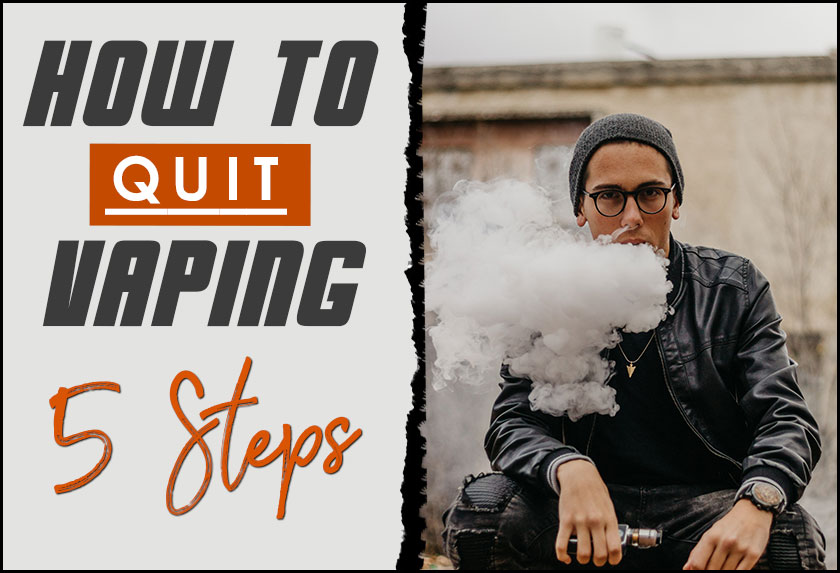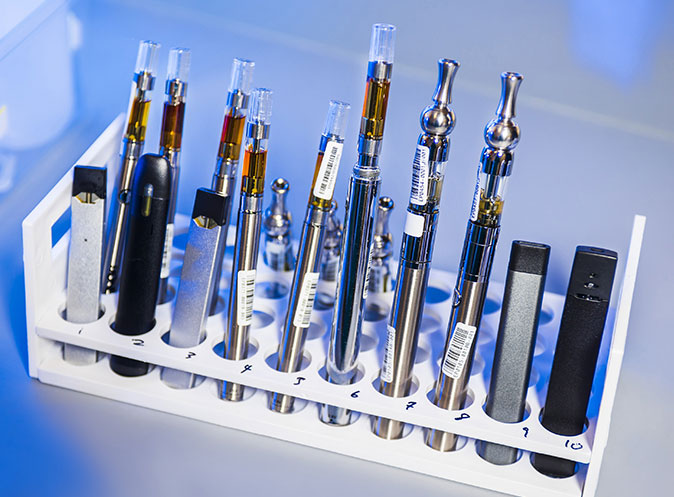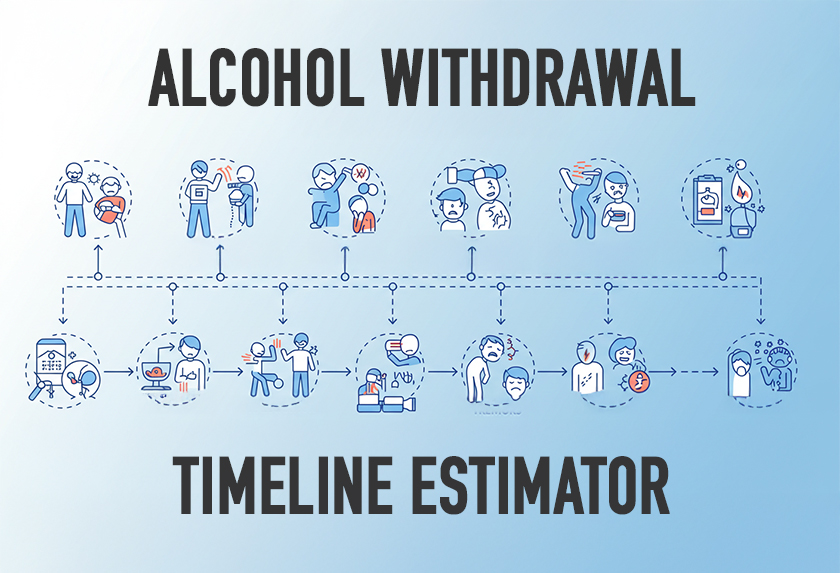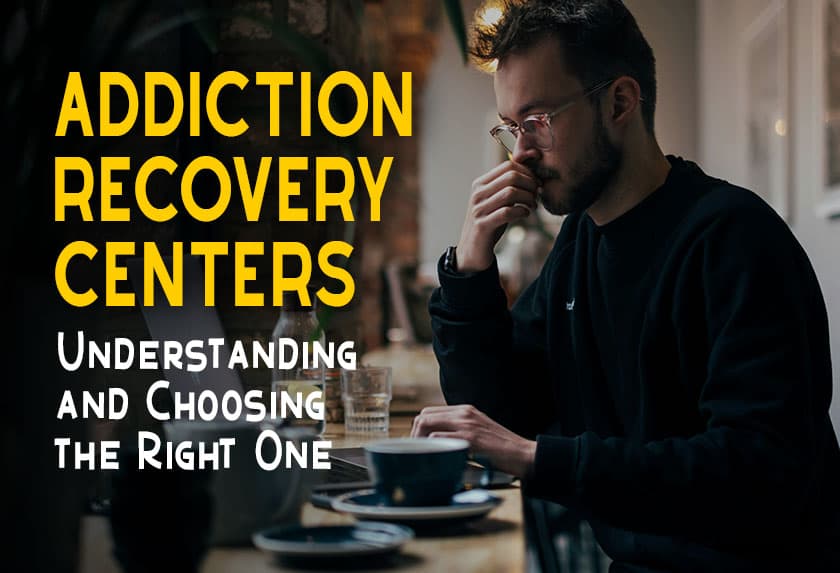Did you know that there were nearly 3,000 hospitalization cases and death related to e-cigarettes as of February 2020? This comes in the wake of disturbing findings by the Food and Drugs Administration (FDA) on the rates of e-cigarette use among young people. According to the study, the use of e-cigarettes has increased dramatically to alarming levels – with 5 million middle and high school students reporting having smoked within the last 30 days.
Contrary to popular belief, vaping is not necessarily a stepping stone from traditional combustible cigarettes. In fact, a 2019 study published in the American Journal of Medicineconcluded that the risk of cardiovascular disease increases by up to 36% when a combustible-cigarette user takes up vaping. The FDA has even come out to slam e-cigarette manufacturers for marketing their products as safer/healthier alternatives to other tobacco products.
Aside from the increasing health concerns, quitting vaping is relatively difficult. Here’s the thing; regardless of what you may have been led to believe, e-cigarettes are just as addictive (if not more) as traditional cigarettes. They both involve the intake of nicotine, which is responsible for the cravings. To add salt to the wound, a person can vape constantly with little-to-no breaks – hence consuming higher levels of nicotine than combustible cigarettes that typically involve breaks in between the smokes.
If overcoming the nicotine addiction and quitting vaping is on your agenda, here are 5 strategies on how to stop vaping.
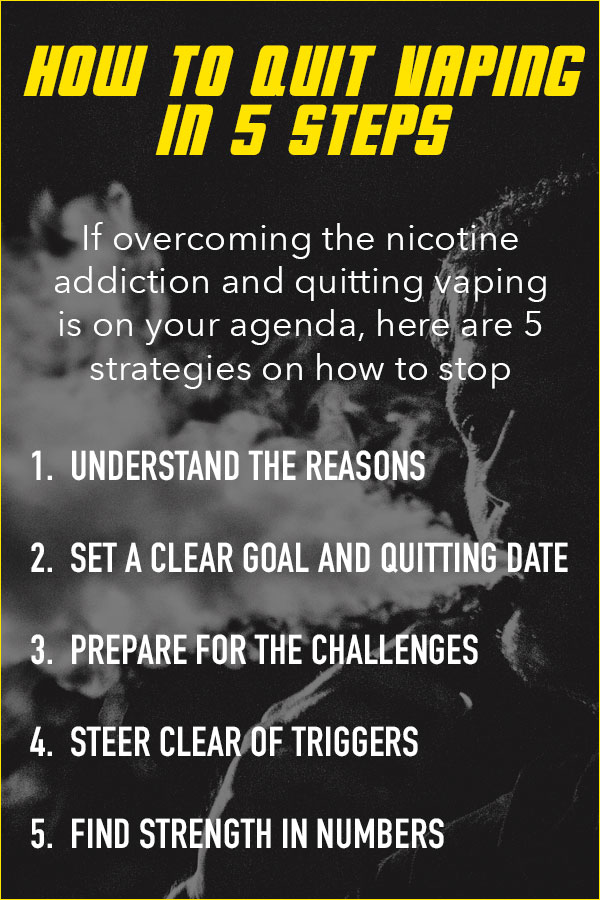
-
Understand the Reasons for Quitting Vaping
The first step on how to quit vaping is putting meaning to your decision. This keeps you focused and motivated to achieve your goals. Why are you quitting? What is the motive behind your decision? There are several good reasons to put away the vape pens – from living healthier lives, saving a ton of money, to social reasons.
Start by knowing the things that matter the most in your life. If vaping in some way drags you back or prevents you from experiencing life as you intend, anchor your quitting motives on those negative repercussions. To help you find a reason to quit vaping, here are a few questions to ponder:
- Does vaping influence how I feel and behave? If so, how is it controlling my life?
- Does the habit interfere with my work or grades?
- Am I jeopardizing my relationships with my family, friends, partner, and other important people in my life?
- How does vaping reflect on my budget and spending habits?
- Which important activities have been negatively affected because of vaping?
- What will I gain by quitting vaping? (Focus on the positive things and what you want to achieve in the future).
The most common reason for quitting is living a healthier and more fulfilling life. The rapidly growing number of hospital admissions and death related to vaping is enough to get users thinking twice about their vaping habits. According to experts, quitting vaping lowers the levels of inflammation in your lungs, reduces vulnerability to bacterial infections, and improves cardiovascular performance.
Another main reason is cutting down on the costs associated with vaping. According to a study appearing in the journal of Tobacco Prevention and Cessation, individuals spend as much as $250 every month – or $50 to $75 on average – to support their vaping habits. Coupled with the potential medical costs due to hospitalization, vaping isn’t worth the hassle for most people.
After you put meaning to your quitting decision, write the reasons down and place them in an easily accessible/visible location. Whenever you’re in doubt or you feel overwhelmed by temptations, look back to why you’re doing this in the first place – it kind of a mental slap to keep you focused.
Based on your reasons for quitting, picture your life free of vaping. Think about how vaping gets in the way of who you want to be in the future. How will your life be different without vaping? Understandably, it may be hard to imagine a life without vaping – especially if the e-cigarettes were part of your daily routine. But vaping does not (and should not) dictate your life or define who you are – you’re the architect of your life.
-
Set a Clear Goal and Quitting Date
This is where you make a mental shift. You’re no longer a person who vapes – that is in the past and you’re now a different person. Make the firm decision to kick vaping to the curb. This involves choosing a clear date to quit and upholding it at all costs. PS: This plan is not advisable for everyone, especially if you get too anxious concerning due dates.
Setting a quit date gives you time to mentally and physically prepare for your noble cause. It allows you to hone the skills and confidence to push through with the decision to quit vaping. Before the quitting date, consider conducting in-depth research on how to quit vaping, the impact of vaping on health, relatable testimonials to motivate you, and some of the possible techniques to overcome nicotine withdrawal symptoms. This is also the time to seek out support groups such as a close family, friends, or experts to keep you in check. But remember:
- Don’t set the date too far into the future: According to the eccentric literary compiler, John Trusler, “No time like the present, a thousand unforeseen circumstances may interrupt you at a future time.” With thin in mind, the date you pick should be close enough to ensure you don’t lose interest or change your mind. As a general rule of thumb, it should not exceed a week.
- Be strategic with your date: Don’t just set a quit date randomly. Consult your schedule and ensure it does not coincide with an important event in your life. For example, quitting right before a big interview creates a stressful environment – and may set you up for failure. It is also important to have a clear plan on what you will do on the life-changing due date.
- Have a reminder in place: Whether it’s drawing a huge red circle on your calendar or setting an alarm on your mobile device, ensure there’s a reminder you can’t miss.
If you’re wary of your future evil self – who is often armed with excuses and procrastination techniques – you can just quit cold turkey. It takes less work and time than formulating a plan. However, the effectiveness of this technique depends on the extent of your nicotine addiction, daily habits, and personality. It requires admirable willpower and the withdrawal symptoms may be intense (though temporary).
-
Prepare for the Challenges – It’s Not Easy, But Worth it!
The truth of the matter is that quitting vaping will not be a straightforward task. Yes, it’s very much possible to live a vape-free life – but there are hurdles along the way. According to a study in the journal of Addictive behaviors that surveyed ex-smokers for 2 decades, 39% of the respondents relapsed but 69.5% of them went on to quit again. This shows that there are challenges but it’s also possible to overcome them.
When you vape or use any other nicotine products, the number of nicotine receptors (nicotinic cholinergic receptors) in the brain increases. Even after you stop vaping, your brain still expects nicotine – hence the craving and withdrawal symptoms. Some of the common vape withdrawal symptoms include:
- Intense cravings for e-cigarettes even though you think they are detrimental to your health
- Feeling irritable, jittery, restless, or anxious when you can’t vape
- Having trouble concentrating or thinking clearly. Thoughts of vaping may keep interrupting you from focusing on other things
- Headaches
- Increased appetite
- Sleeping problems
- Feeling groggy or tired
- Depression and mood swings. You may feel sad or down.
How Long Does It Take To Quit Vaping?
How long does nicotine withdrawal last? Nicotine generally takes around 3 days (72 hours) to leave your body, but it takes up to 3 months for the symptoms to go away and for your brain chemistry to adjust (depending on the history of nicotine use). Below is a nicotine withdrawal timeline after vaping your last e-cigarette.
- Immediately after the last e-cigarette: You’ll likely feel a sense of panic knowing you’ve just vaped your last e-cigarette. The thought of quitting vaping forever might seem intimidating. To avoid feeling overwhelmed, take it one day, one hour, and one minute at a time. Learn from your past and live in the present to achieve your future goals.
- 4 hours: You start craving another e-cigarette after the effects from the nicotine begin to wear off. Your brain begins to crave another hit to quench the nicotine addiction.
- 10 hours: You start to have trouble sleeping due to restlessness. You may even feel hopeless and sad as you wonder how you’ll fill the time.
- 1 day: At the 24-hour mark of the nicotine withdrawal timeline, irritability kicks and you feel angry or dissociated to the world.
- 2 days: As the nicotine leaves your body, you’re left with pesky headaches. At this stage, it’s important to understand that the e-cigarettes are the cause of the pain and not the cure.
- 3 days: You experience heightened stress or anxiety, followed a craving relief.
- 7 days: A week free of vaping is a significant achievement and milestone in the nicotine withdrawal timeline.
- 4 weeks: In the coming weeks, you will still feel slight effects from the nicotine withdrawal but your appetite, mood, and brain fog should be clearing up.
After you have a rough idea of how long nicotine withdrawal lasts, it is up to you to prepare for the upcoming cravings and resist temptations. Knowing what to expect allows you to formulate a strategy for handling the uncomfortable feelings when they arise. Welcome the change and understand that withdrawal symptoms are temporary and the cravings shall pass.
-
Steer Clear of Triggers – Coping Strategies
Certain situations, feelings, or people can encourage the urge to vape. Therefore, it’s crucial to identify and steer clear of your vaping triggers. This should start in the early stages of quitting vaping and go on for as long as possible. Triggers generally fall into the following categories:
- Emotional triggers: If you’re accustomed to vaping as an escape for negative feelings or a reward for excitement, these intense emotions may trigger a desire to vape. Some of these feelings include anger, happiness, excitement, loneliness, boredom, sadness, anxiety, and stress. In such scenarios, find healthier alternatives to cope with the emotions.
- Social triggers: Do you always find yourself vaping when you’re around certain people, parties, or certain social gatherings? If so, it’s best to avoid them as you try to quit vaping. If your family or close friends are the ‘culprits,’ let them know of your decision and ask them to be supportive.
- Withdrawal triggers: If you’ve been vaping for a long time, it becomes a part of you. The scent of e-cigarettes, the feeling of the pen in your mouth/hands, and the act of handling lighters may affect the severity and frequency of your withdrawal symptoms. Since you can’t avoid these triggers per se, it’s advisable to distract yourself or find healthier alternatives when the craving kicks in.
- Pattern triggers: Are there activities that you instinctively associate with vaping? Maybe finishing a meal, work breaks, watching TV, or even sex? You need to break this association.
Sometime the trigger may feel overwhelming and a voice inside your head may whisper, “just vape one e-cigarette, it won’t count.” When this happens, understand that it’s a trap and if you cave, you’ll have to start the detox process all over again. To help you bolster your willpower, here are a few recommendations to make the change easier.
- Throw out the gear to help quit vaping: As soon as you decide to quit vaping, get rid of all vape gear. You no longer vape and you don’t need the lighters, e-cigarettes, or other items directly related to vaping. Avoid saving things for “just in case” – do not tempt fate!
- Find substitutes: One of the best ways to steer clear of triggers is by keeping yourself occupied before/when the thought of vaping crosses your mind. The aim is to find a good substitute that can overcome the fixation of vaping. For oral or physical habits, some substitutes include bubble gum, carrots, pumpkin seeds, toothpicks, pretzels, popcorn, or chewable straws. You can also take a shower, brush your teeth, drink water, or take a walk to distract you from the urge to pick up an e-cigarette. To overcome the mental side of the triggers, give yoga and meditation a try. In the words ofEarl Nightingale, “Whatever we plant in our subconscious mind and nourish with repetition and emotion will one day become a reality.”
- Consider medical intervention: Depending on the severity of your withdrawal symptoms, you may look into pharmaceutical medications such as bupropion or varenicline to help you quit vaping. You can also follow up on professional therapy and counseling to leverage evidence-based techniques.
-
Find Strength in Numbers
YOU ARE NOT ALONE! Find comfort and motivation from colleagues, family, friends, and supports groups. Surround yourself with people who are supportive and make the challenges easier. Having professionals or people who have overcome addictions can also teach you how to quit vaping.
Don’t be afraid to reach out and clearly state the type of help you need. For example, if you tend to feel anxious after-work – triggering the urge to vape – talk to your friend or spouse and ask them to distract you. And remember to be appreciative of the assistance and reciprocate the support. If another vaper shows interest in your resolution, show them how to stop vaping and change their lives too. Use your knowledge and experiences to teach them important things such as answering, “how long does nicotine withdrawal last” and other relevant questions on how to quit vaping.
While accentuating the positive support team, also avoid the negative influences. If someone is not supportive of your decision to quit, ask them to at least respect your choice, remind yourself why quitting vaping is important, or distance yourself from them.
At the end of the day, celebrate your victories and keep going!
Please note that the suggestions of this article are for informational purposes and are not intended to substitute medical advice. Always consult a qualified health provider regarding your health objectives.

